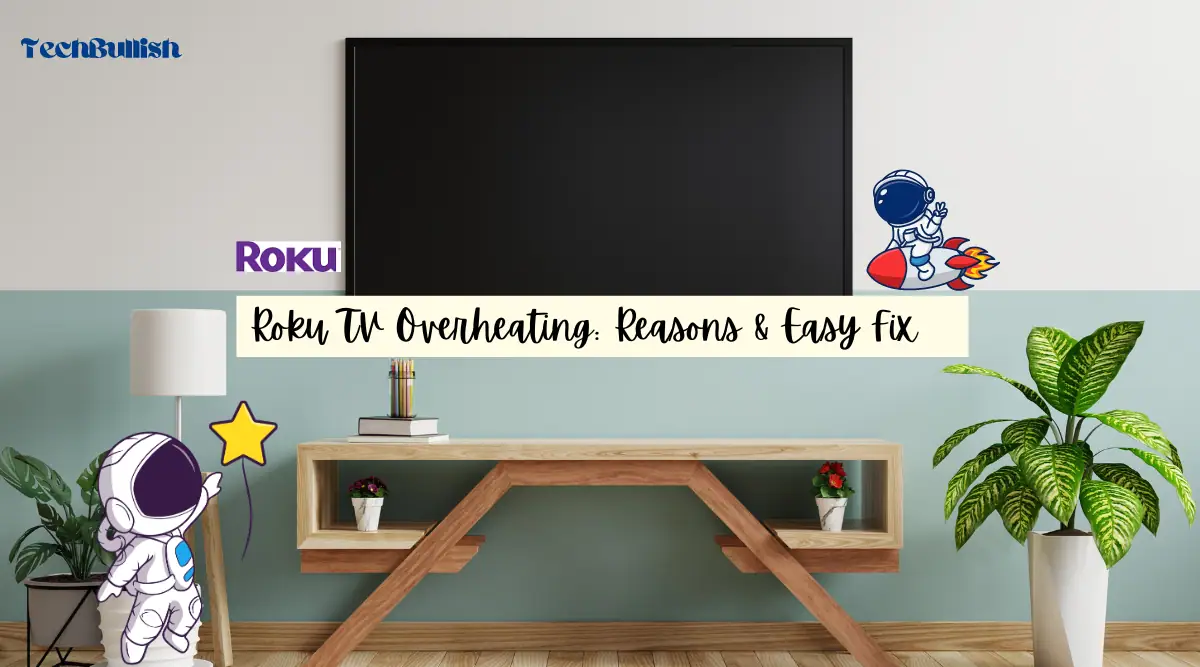Roku TVs provide a convenient way to access a wide range of streaming services and channels.
However, one issue that users may encounter is overheating.
In this article, we will explore the reasons behind Roku TV overheating, how to fix it, what to do when your Roku overheats, and some preventive measures to avoid overheating in the first place.

Let’s get started!
Why is my Roku TV Overheating?
Overusing the device
One of the common reasons why a Roku TV may overheat is due to overuse.
Streaming for extended periods without giving the device a break can cause it to get too hot.
It’s important to take breaks and allow the device to cool down.
Blocked ventilation
The design of Roku TV includes ventilation slots to allow airflow and keep the device cool.
If these ventilation slots are blocked, either by placing the device in a confined space or by placing objects on top of it, it can restrict airflow and result in overheating.
Placing the device in a closed environment
Another factor that can contribute to Roku TV overheating is placing the device in a closed environment.
Closed cabinets or enclosures can trap heat and prevent efficient dissipation, leading to the device getting too hot.
It’s important to ensure that there is enough space and airflow around the device.
Using an inadequate power cord
Using a power cord that is not specifically designed for your Roku TV can lead to overheating.
Make sure to use the correct power cord that came with the device or a compatible replacement.
Plugging too many devices into the HDMI ports
If you plug too many devices into the HDMI ports of your Roku TV, it can lead to overheating.
The strain on the HDMI ports can cause the device to heat up quickly.
Be mindful of the number of devices connected and consider using an HDMI switch or extender if needed.
How can I fix Roku TV Overheating?
Clean your Roku TV
Dust accumulation can hinder the device’s ability to dissipate heat properly.
Regularly cleaning your Roku TV with a soft, dry cloth can help prevent dust buildup and improve its cooling efficiency.
Move your Roku TV to a well-ventilated area
If you notice that your Roku is overheating, try moving it to a well-ventilated area.
Ensure that the ventilation slots are not obstructed and that there is enough space around the device for proper airflow.
Use an HDMI extender
In some cases, using an HDMI extender can help alleviate overheating issues.
An HDMI extender can reduce the strain on the HDMI port by allowing you to position the Roku TV in a different location.
This can help improve airflow and prevent overheating.
Update to the Latest Roku Software Version
Updating your Roku TV to the latest software version can also help to prevent overheating issues.
Roku TVs are designed to automatically check for and install software updates, but you can also manually check for updates by going to Settings > System > System update.
If an update is available, follow the on-screen instructions to install it.
Power Cycle Your Roku TV
If your Roku TV is overheating, one solution is to power cycle it.
This can be done by unplugging the TV from the power source, waiting for a minute, and then plugging it back in. This may help to resolve the issue.
Factory Reset Your Roku TV
Another solution to fix overheating issues with your Roku TV is to perform a factory reset.
This will erase all settings and data on the TV, so make sure to back up any important information before doing so.
Factory Reset Method Using Remote and Roku TV Menu
To factory reset your Roku TV, you can access the settings from the Home screen on your Roku remote.
From there, select “Settings”, then “System”, followed by “Advanced system settings”. Scroll down and select “Factory reset”, and then follow the prompts to reset the device.
Reset Method Using Roku TV Reset Button
If you can’t access the settings due to a black screen, you can reset the Roku Smart TV using the reset button on the back or bottom of the device.
Simply press and hold the reset button for approximately 20 seconds until the LED light on the front of the Roku TV begins to flash, release the button, and wait for the TV to restart.
Contact Roku TV Customer Support
This is the recommended step if your Roku TV is under warranty and previous steps didn’t fix the issue. They will diagnose and fix any issue including internal hardware issue if any.
They can assist with troubleshooting the issue and may be able to provide further guidance on how to resolve it.
- Contact information for Roku TV customer support can be found on their website.
- You can also contact Roku Support using their twitter support @RokuSupport.
How to prevent Roku TV overheating?
Avoid placing your Roku TV in direct sunlight
Direct sunlight can cause the temperature inside your Roku TV to rise significantly.
To prevent overheating, avoid placing your Roku in direct sunlight or near heat sources.
Keep the Roku TV away from dust
As mentioned earlier, dust can obstruct the ventilation slots and hinder the device’s cooling capabilities.
Regularly dust the area around your Roku Smart TV and avoid placing it in dusty environments.
Ensure proper airflow around the TV
To prevent overheating, it’s crucial to provide adequate airflow around your Roku TV.
Avoid placing it in cramped spaces or stacking other electronic devices on top of it. Allow for proper ventilation to keep the device cool.
Frequently Asked Questions
What can cause my Roku TV to overheat?
How can I prevent my Roku TV from overheating?
Can a HDMI extender cause my Roku TV to overheat?
What should I do if my Roku TV is overheating?
Will my Roku TV display a warning message if it overheats?
Why does my Roku TV get warm?
Should I unplug my Roku TV if it overheats?
Can a Roku stick also get hot and overheat?
What should I do if I see a blinking red light on my Roku TV?
Can the power cord of my Roku TV cause overheating?

Jefferson McCall is the tech-savvy co-founder of TechBullish, brings his passion for electronics to life through hands-on expertise. He has a deep understanding of embedded systems and consumer electronics from his decade of industry experience repairing and troubleshooting them. He spends time learning new and evolving technologies. Check Jefferson’s Crunchbase Profile here.
